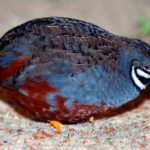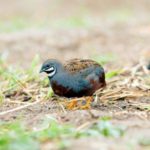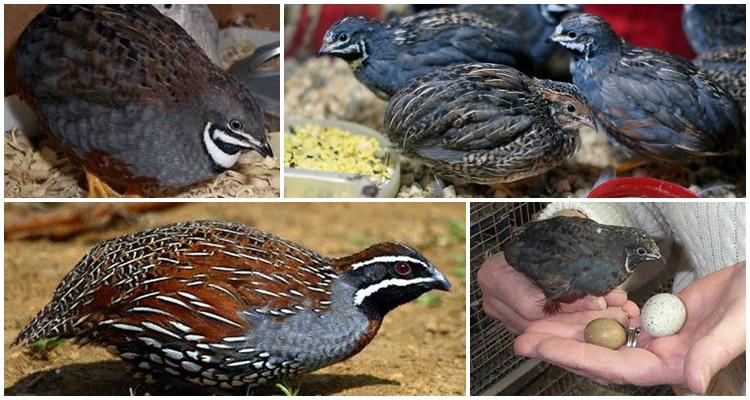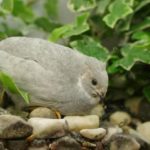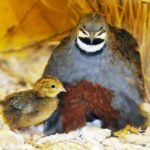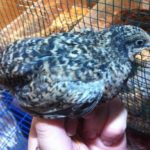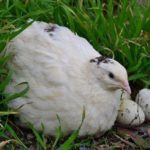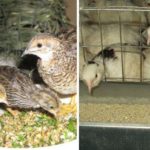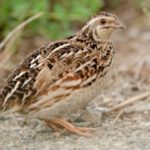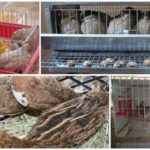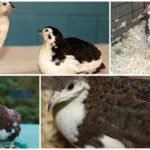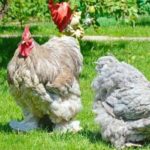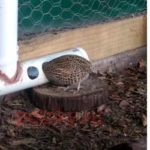Quails are not large in size, but they are also raised for meat and eggs. These birds belong to different breeds. Let's consider the description and characteristics of the Chinese painted quail, the pros and cons of the breed, the rules for keeping and feeding birds, and caring for them. Features of breeding Chinese quails and protection against diseases at home.
Features, description and characteristics of the Chinese Painted breed
The Chinese quail belongs to the pheasant family. The birds are small in size, the weight of an adult is 45-70 g.Females are smaller than males and differ from them not only in size and weight. You can identify a bird by gender by its plumage. Females (like many wild birds) are gray-brown and inconspicuous. Males are dark brown, have a blue-gray chest, dark red feathers on their bellies, and black and white feathers on their necks. The wings may have a light pattern made up of brown feathers. Both sexes have a black bill and orange or yellow legs.
The body length of the Chinese quail is up to 14 cm in the male and up to 12.5 cm in the female. From them you can get eggs weighing 10 g. Females begin laying eggs at the age of 6 months, laying 150-200 eggs per season. Quail eggs are considered a dietary food; they contain many vitamins; for example, to obtain the daily requirement of vitamin D, you will need to eat 2 pieces per day.
Positive and negative sides
Advantages of Chinese quails:
- unpretentiousness, you can keep them in cages or small enclosures;
- are fed on standard food;
- The chicks hatch well in the incubator.
Flaws:
- small size and weight,
- heat-loving birds, in winter they need to be kept in a heated room;
- under poor living conditions, they pluck each other's feathers.
Despite the breed's shortcomings, it is eagerly raised by farmers and poultry farmers for their own consumption of meat and eggs.
Maintenance, care and feeding
Quails do not take up much space; they can be kept in any utility room and even in an apartment. They can live in a mesh cage, but it should not be too cramped; 10 cm of area should be allocated for 1 bird. Cages can be stacked in tiers on top of each other. In an apartment, Chinese quails can be placed on a closed balcony or loggia so that there is no unpleasant odor in the room.
If the room is small, you can heat it with portable oil radiators. There should be no drafts in the room. Proper lighting is another indispensable condition for keeping quails. The daylight hours should be 18 hours, supported by artificial lighting. Then turn off the light for 2 hours, then turn it on again for 2 hours and turn it off again for 2 hours. To create such a scheme, it is convenient to use a system that will automatically turn the light on and off.
Caring for Chinese quails consists of cleaning the cage, feeding and watering the birds. The floor in the cage is made of fine mesh; a tray is placed below, into which droppings fall. To prevent odor, ventilate the room every day. Feeders are hung on the outside of the cage wall, the birds stick their heads through the mesh and eat the food. The drinking bowls are either ordinary or nipple. The laid eggs roll down an inclined floor into a special receptacle, from where it is convenient to select them.
Small Chinese quails are fed 5 times a day, after they reach 1 month - 3 times. The first food for them is a soft, easily digestible mixture of boiled eggs, chopped greens, and the smallest grains. A drinking bowl can be made from an inverted 0.5 liter jar placed on a saucer.
Adult Chinese quails are fed mash of millet, grain chaff, grass, and grated root vegetables. You can give them some chopped fruits and berries. In winter, the diet can be enriched with dried herbs and grated carrots. Drinking water should be warm and always clean.
Like other birds, Chinese quails require coarse sand for digestion. It is washed, dried, poured into a small container and placed in a cage.
Chinese quails can be fed with compound feed throughout their life. They grow well on it and lay eggs. Feeding with compound feed is convenient, it lasts for a long time, and does not deteriorate in a dry and dark place.
Breeding and disease protection
The ratio of breeding males and females among Chinese quails should be as follows: for 1 quail, 3 quails. Different families need to be housed separately; if they live together, the males will fight with each other. Only females can be kept together to produce eggs and males for fattening for meat. It is better to hatch quails in an incubator rather than under a hen. An ordinary home incubator will cope with this task perfectly. You need to put a hatching egg from a purebred bird in it to get purebred quails.
Quails suffer from infectious diseases and eating disorders. To prevent infections, birds are treated with antibiotics. To avoid disorders, it is necessary to monitor the diet and feeding regimen. If diseases or nutritional disorders are detected, sick quails are separated and treated. Healthy livestock are fed for preventive purposes; drugs are taken in smaller doses than usual.
Chinese quails are raised by poultry farmers for meat and eggs. But because of their beautiful plumage, they can be bred and kept as an ornamental bird. Keeping, feeding and breeding quails of the Chinese breed is no different from raising these birds of other varieties, and therefore should not cause difficulties for an experienced owner.

